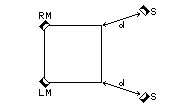
The speed of sound is 1130 feet per second (344 meters per second).
The distance d needed in feet is the delay time in seconds times 1130.
The distance d needed in meters is the delay time in seconds times 344.
For a delay of 20 ms, the distance d needed is .02 X 1130 = 22.6 feet.
So you need to be able to place the speaker 22.6 feet away from the listener.
The volume setting for the delayed speaker may have to be higher to achieve the desired effect.
This is a long distance for an average listening room.
Approximately half of the room can't be used for surround listening with this system.
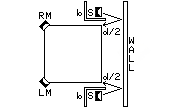
The distance d/2 needed in feet is half the delay time in seconds times 1130.
For a delay of 20 ms, the distance d/2 needed is .02 ÷ 2 × 1130 = 11.3 feet.
So you need to be able to place the speaker near the listener, aimed at a wall 11.3 feet away from the listener.
The speaker would have to be acoustically shielded with baffle b so the listener can't hear the speaker directly.
The far wall must be acoustically reflective for this to work.
The volume setting for the delay speaker may have to be higher to achieve the desired effect.
This is still a long distance for an average listening room.
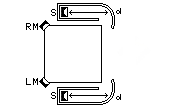
The total length of the tube d must be the delay time in seconds times 1130.
For a delay of 20 ms, the length needed d is .02 X 1130 = 22.6 feet.
So you need to be able to place the speaker at the end of the tube 22.6 feet away from the listener.
The volume setting for the tube speaker may have to be higher to achieve the desired effect.
The tube must be semi-reflective and the walls must be impervious to sound.
The tube must be at least the speaker size, if not larger.
The tube could cross the listening room in one direction to release sound at the other end.
If the tube bends at the end, that end must be more reflective to sound.
The tube does not need to be a cylinder. It can be a pocket or open closet in a room.
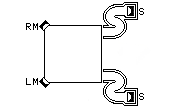
The total length of the tube must be the delay time in seconds times 1130.
For a delay of 20 ms, the length needed is .02 X 1130 = 22.6 feet.
So you need to be able to place the speaker at the end of the tube that winds for 22.6 feet.
The volume setting for the tube speaker may have to be higher to achieve the desired effect.
The tube must be sound-reflective and the walls must be impervious to sound.
Angled sound reflectors can be placed where the tube bends to change the direction of the sound.
The tube does not need to be a cylinder. It can be a pocket or open closet in a room.
The tube could have any path or shape, including a helix or maze.
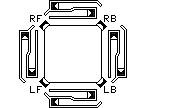
The total length of the tube must be the delay time in seconds times 1130.
For a delay of 20 ms, the length needed is .02 X 1130 = 22.6 feet.
So you need to be able to place the speaker at the end of the tube 22.6 feet long.
The volume setting for the delay speaker may have to be higher to achieve the desired effect.
The tube must be sound-reflective and the walls must be impervious to sound.
Angled sound reflectors can be placed where the tube bends to change the direction of the sound.
The tubes can be on the ceiling or under the floor to allow people to enter the room.
All three speakers in a corner are connected to the same amplifier. L-pads can be used to vary the levels.
Notice that this also removes the side imaging problem that occurs with discrete surround sound.
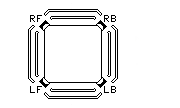
The total length of the tube must be the delay time in seconds times 1130.
For a delay of 20 ms, the length needed is .02 X 1130 = 22.6 feet.
The tube space must be 22.6 feet long.
Dampers in the tube may be needed to achieve the desired effect.
The tube must be sound-reflective and the walls must be impervious to sound.
Angled sound reflectors can be placed where the tube bends to change the direction of the sound.
The tubes can be on the ceiling, under the floor, or side pockets in the wall.
Extra speakers may be needed to feed the tubes.
Sound enters both ends of the tubes. Each sound exits the other end of the tube.
Notice that this also removes the side imaging problem that occurs with discrete surround sound.
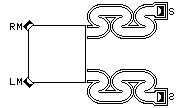
The total length of the tube must be the delay time in seconds times 1130.
For a delay of 80 ms, the length needed is .08 X 1130 = 90.4 feet.
The tube space must be about 90.4 feet long.
The tubes do not have to be the same length for this effect.
The tube must be sound-reflective and the walls must be impervious to sound.
The volume setting for the delay speaker may have to be higher to achieve the desired effect.
Angled sound reflectors can be placed where the tube bends to change the direction of the sound.
The tubes can be on the ceiling, under the floor, or side pockets in the wall.
A larger tube can produce a more diffused effect.
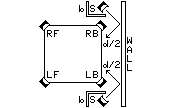
The distance d/2 needed in feet is half the delay time in seconds times 1130.
For a delay of 20 ms, the distance d/2 needed is .02 ÷ 2 × 1130 = 11.3 feet.
So you need to be able to place the speaker S near the listener, aimed at a wall 11.3 feet away from the listener.
The speakers S would have to be acoustically shielded with baffle b so the listener can't hear the speaker directly.
The far wall must be acoustically reflective for this to work.
The volume setting for the delay speaker may have to be higher to achieve the desired effect.
A special signal for L-R or R-L must be provided for the S speakers.
Notice that this also removes the side imaging problem that occurs with discrete surround sound.